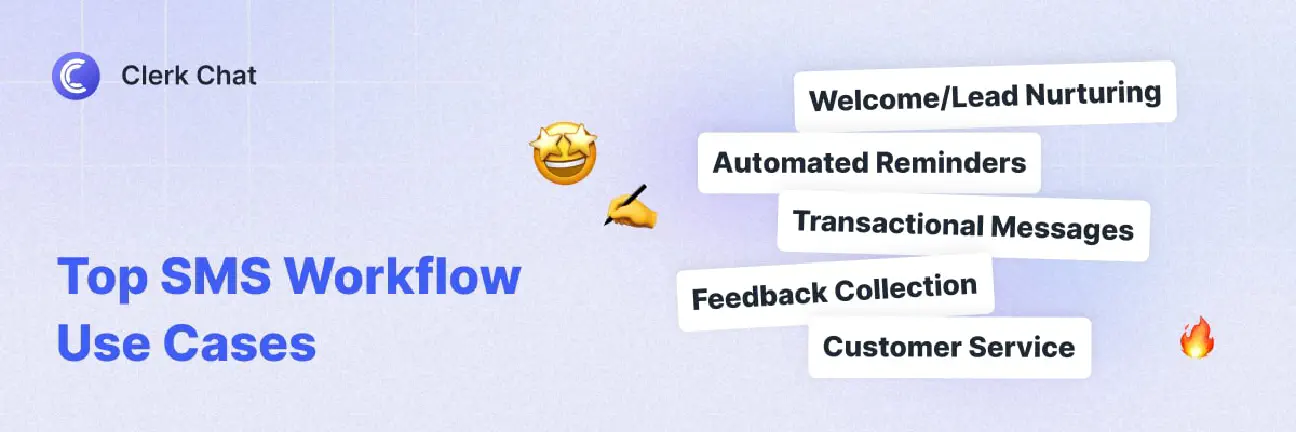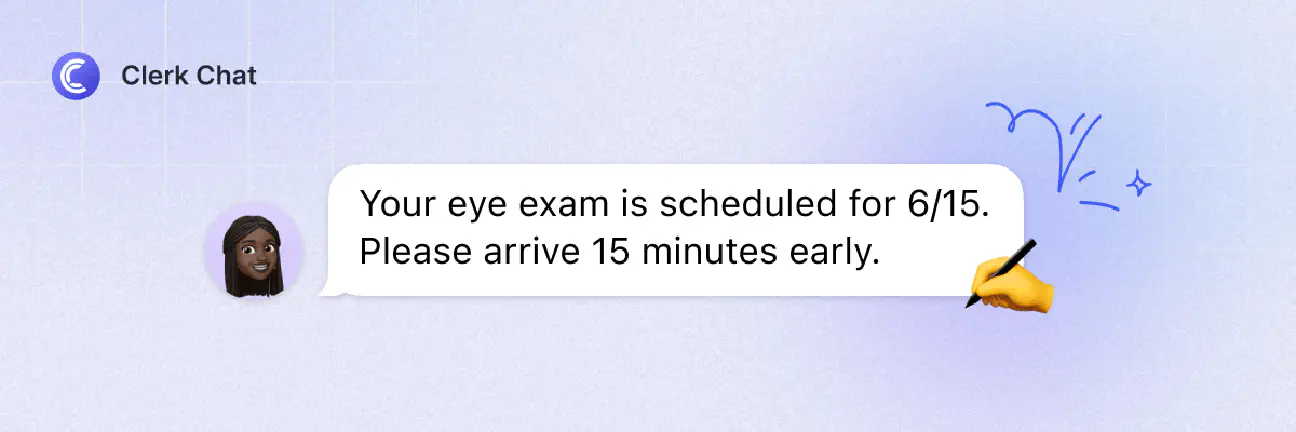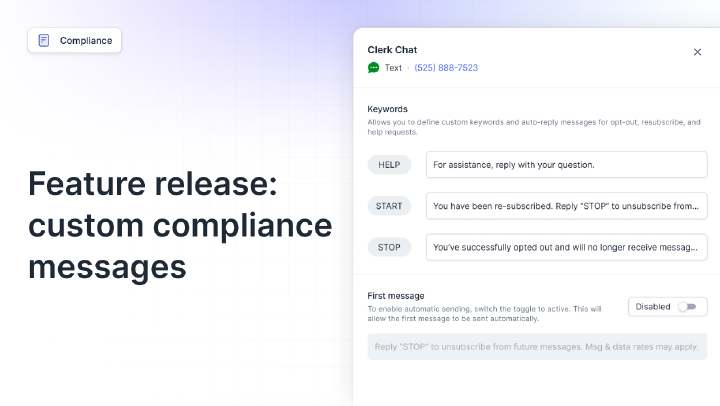SMS Workflow Automation: The Complete Guide to Building Effective Workflows
By Jill Berkowitz
- Updated: October 23, 2024
SMS workflow automation strategies are becoming increasingly valuable for companies that want to boost efficiency, reduce costs, and increase customer engagement.
With an automated messaging solution, you can minimize the time employees spend on repetitive tasks, like sending automated purchase confirmation messages to buyers or following up with service-based texts.
More importantly, you can ensure you’re connecting with your audience at the right time, to boost conversion rates and adhere to SMS compliance laws. Of course, for the best results, you need the right strategy. Here’s everything you need to know about SMS workflows, how they work, and how you can achieve incredible results with Clerk Chat!
What is an SMS Workflow?
An SMS workflow is a strategic series of automated text messages you send to customers based on a specific trigger. For instance, you might use scheduled text messaging to notify customers about a new product launch or sale, or you might set up automated campaigns for transactional messages, like notifications that let customers know their order is in transit.
Workflow automation is common in today’s business landscape. It’s how you minimize the cumbersome and time-consuming manual routines in your day-to-day operations into streamlined, efficient experiences.
Many companies already use automated workflows for things like task assignment, document processing, and even customer relationship management. With SMS workflows, the focus is typically on improving customer experiences, increasing engagement, and boosting sales.
After all, SMS is one of the most convenient ways for companies and customers to communicate – and one of the most effective.

The Benefits of Automating SMS Workflows
Perhaps the biggest benefit of SMS workflow automation is it saves businesses and teams significant time. By automating repetitive tasks like sending reminder texts or chasing approvals, you ensure your team can redirect their energy toward more value-added projects.
Beyond boosting efficiency and productivity, automation can:
- Reduce human errors: Human beings make mistakes, particularly when they’re working on monotonous, time-consuming and repetitive tasks. The workflows feature in Clerk Chat makes it easy to reduce errors, and maintain brand consistency, with pre-set rules, configuration options and templates.
- Access valuable data: With the right platform for SMS automation, you’ll be able to access valuable insights into metrics like open rates, and customer engagement. This means you can identify bottlenecks and make informed decisions about how to improve results.
- Improve customer engagement: Whether you’re sending healthcare SMS appointment reminders or promotional texts, automation allows you to ensure messages reach your customers at the right time. This can boost your chances of connecting regularly with your customers, increasing conversions, and retaining customer loyalty.
- Improved ROI from SMS: Text messaging can deliver incredible results to businesses. SMS workflow automation helps you scale those benefits, ensuring you can rapidly promote new products, and respond to customer queries without investing in additional human resources.
- Reduce compliance risks: Various mandates require companies to adhere to specific standards when sending messages to customers. For instance, for 10DLC SMS compliance, you need to ensure you’re not messaging customers at inappropriate times. An automation strategy can help you to adhere to these rules.
In a nutshell, workflow automation isn’t just a technological upgrade; it’s a strategic move that empowers businesses to thrive.
Example SMS Workflow Use Cases
As mentioned above, one of the biggest benefits of SMS workflow automation is that it’s extremely versatile. The right tools empower companies to automate everything from capturing information from SMS leads, to streamlining customer service.
Some examples of use cases for SMS workflows may include:
Welcome Messages and Lead Nurturing Campaigns
Have you ever wondered how companies manage to send welcome messages to their customers within seconds of them filling out a lead capture form? It’s a result of effective workflow automation. Companies in all industries use automation to trigger welcome messages to be sent to customers as soon as they “opt in” to a contact list.
Beyond this, companies can build entire welcome and lead nurturing series campaigns, introducing customers to their top-selling products, answering common questions and more.
Automated Reminders
Reminders are another common use case for SMS workflow automation. In service-based industries, companies can automatically send messages to customers reminding them about upcoming appointments, events, or deliveries. For instance, a business using SMS for finance could remind their customer they have an investment appointment at the end of the week.
You can even use automation to remind customers about products they’ve left in their basket, nudging them towards conversions after they abandon your website.

Transactional Messages
Transactional messages can be an excellent way to improve the customer experience, keeping your target audience informed, and helping them to complete tasks, like changing an account password. You can create SMS workflow campaigns that inform customers when you receive an order, process it, and ship it out for delivery.
Plus, you can use transactional messages to keep customers up-to-date on any delays in their orders, changes to your services, and more.
Feedback Collection Messages
Collecting customer feedback is crucial to ensuring you’re not only delivering the best products and services, but also constantly exploring ways to boost engagement and retention.
For instance, a company using an eCommerce text messaging platform could automatically ask customers to review a purchase, leave feedback about a customer service interaction, or suggest a new product they want to see.
You could even automatically deliver discount codes and vouchers to customers who share feedback, rewarding them for their continued engagement with your brand.
Customer Service Solutions
Although some customer support and service interactions will require real one-on-one interaction with a human, some processes can be automated with an SMS workflow. For instance, if you send an appointment reminder SMS to a customer, you can give them the option to request a change of date, or ask for instructions on how to reach your location (for in-person appointments).
You can even use AI tools to answer common questions customers might have about delivery times, refund and return processes, and more. Or you could improve customer service experiences proactively, by automatically notifying customers who reach out to your teams when your team members are available for a conversation.
SMS Workflow Automation Best Practices
By now we’re all used to notifications. A flash sale at your favorite store, your upcoming doctor’s appointment, or even a personalized discount code. This is the power of SMS – a direct and immediate communication channel that bridges the gap between you and your customers.
Using SMS for business communication can boost engagement rates, customer satisfaction, and conversions. As mentioned above, SMS workflow automation helps to scale these results, but it’s important to take the right approach.
Automation shouldn’t make your messages feel impersonal or robotic. You still need to personalize messages, and explore various strategies to make customers feel special.
Here are some best practice techniques to keep in mind:
Select the Right Workflow Automation Platform
Be strategic about your choice of platform for SMS workflow automation. Before you choose a platform, ask yourself what you want to accomplish. Do you want to increase engagement, improve customer response times, or unlock new opportunities with 2-way texting?
Establishing goals will help you determine what kind of features you need, from built-in templates for different campaigns, to reporting and analytical tools.
It’s also worth ensuring that your chosen platform is easy-to-use, customizable, and flexible. Find a solution that integrates with your existing systems, like CRMs and productivity tools. Clerk Chat, for instance, makes it simple to import your HubSpot contacts, and if you already use Microsoft Teams or Slack, we integrate with those platforms, too. These integrations enable data to flow seamlessly and just makes the bigger picture so much more attainable.


Remember SMS Compliance
Automating campaigns can help you adhere to compliance standards, by ensuring you include the right information in all messages, and send your texts at the right time. However, it’s important to ensure you’re familiar with compliance standards before you dive in, to reduce your exposure to risks.
Read up on TCPA compliance standards, and the CAN-SPAM text mandates to ensure you know when to send messages, and what kind of information you can share via SMS.
Ensure you always get permission from your customers to contact them with promotional messages, and keep track of your opt-in and opt-out rates.

Personalize the Experience
As mentioned above, automated messages shouldn’t feel impersonal. Think about how you can infuse your SMS workflow with personalized elements. For instance, can you send specific messages to customers based on triggers connected to their birth date or anniversary with your company?
Does your SMS platform allow you to segment customers into different groups based on demographics and purchasing history? If so, you can use segmentation to personalize messages throughout the customer journey and improve the experience buyers have with your company.
You might even decide to adjust your SMS templates based on what you learn about different customer preferences, or you might schedule messages differently for various customer groups.
Experiment, Learn, and Optimize
Finally, while there are some best practices you should be following for all SMS workflows, such as keeping messages short and simple, delivering a clear call to action in each text, and adhering to compliant communication standards, there’s still room for experimentation.
Explore different workflows and opportunities, changing your timing, the structure of your campaigns and other factors to see how these alterations influence your results. Focus on things like:
- Open rates and delivery rates
- Click-through rates
- Unsubscribe rates
- Direct customer feedback
As you start to unlock new benefits from automation, look for other workflows you can automate to scale your results. For instance, you might start with automated transaction messages, then move onto two-way text automation with AI for customer service.
How to Create an SMS Workflow with Clerk Chat
Now you know how SMS workflows work, and what you can do with them, the next step is experimenting with strategies of your own. Clerk Chat makes workflow automation in the SMS landscape simple. All you need to do is create an account (there’s a free trial available), and you can start building all kinds of unique workflows.
You can set up campaigns for out-of-office messages, appointment reminders and more, all while adhering to compliance standards. Plus, with our in-depth reporting and analytical tools, you’ll be able to consistently optimize your results over time.
Here’s an example of how you can use Clerk Chat to create a custom workflow:
- Log into your Clerk Chat account.
- Navigate to workflows and select create workflow.
- Choose a trigger. For instance, if you want to send an automated out-of-office message to any customer contacting your company, you can choose “incoming message”.
- Drag the schedule item from flow control onto the plus sign on your board.
- Click schedule, and use the sidebar to enter a name for your workflow in item name, select the proper time zone, and the days for the workflow.
- Save your changes. (Can’t forget this step!)
- Now, you’ll drag send message from assigned inbox to the plus sign below true. Click send message in your workflow to customize, including the text of your outgoing message.
- Once saved, again, you’ll notice at the top of your screen that the title is unnamed workflow. Rename it and click the checkmark.
- At this point, you’ll be prompted to choose an assigned inbox.
When in doubt, save, save, save. You can always go back to revise, edit, or delete.
Use SMS Workflows to Enhance Business Growth
Automation is a powerful tool. If you haven’t discovered the power of SMS workflow automation for your business yet, now is the perfect time to get started. Once you discover the results you can achieve with the right strategy and platform, you’ll wonder why you didn’t dive in sooner.
Whether time is of the essence or you’re looking to simplify your communication strategy, Clerk Chat will help you make the most of your SMS strategy.
Experience workflows in action.
Curious to learn more about Clerk’s features? Subscribe to our YouTube channel for step-by-step tutorials and expert tips!
Jill is a former middle school ELA teacher who has discovered a fascination for content in the B2B tech world. When she isn't writing for Clerk Chat or hosting the 160 Characters podcast, she can be found spending quality time with her husband, three children, and their dog. Follow her journey on LinkedIn.
In this article:
Ready to use your business number for text messaging?
Thousands of businesses are already experiencing the power of conversational messaging through SMS. Join us. Free trial and paid tiers available.
Get Started#Subscribe
Get product updates in your inbox
Tutorials, features, and Clerk Chat news delivered straight to you.




